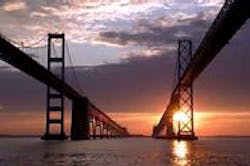"We are a growing nation, adding 150 million people every 50 years [and] 90% of miles traveled by Americans in this vast country are on highways. To meet the nation’s needs we must preserve the highway and transit systems built over the last century and add capacity to keep America competitive in the world economy and meet growing mobility needs here at home." –John Horsley, executive director, Association of State Highway and Transportation Officials (AASHTO)
The Association of State Highway and Transportation Officials (AASHTO) and the American Public Transportation Association (APTA) released big, fat report today called “The Bottom Line” that makes for some interesting reading – especially in terms of the money we’re supposedly going to need to keep our roads in good shape.
By 2015, the reports states, governments at all levels will need to more than double their spending on highways and bridges to keep up with increased traffic, freight congestion, the demands of aging highways and bridges, and the growth of the nation's population – with transit spending would need to triple to serve increased ridership.
As a result, AAHSTO and APTA said an annual investment of $166 billion for highways and bridges is necessary between 2010 and 2015 to improve the condition and performance of the system – given an expected rate of travel growth of 1.4 percent per year. If travel growth is held to about 1.0 percent a year, which would help reduce greenhouse gas emissions, then needed investment to improve the highway system would come to $132 billion per year.
However, in 2006, highway capital investment from all levels of government totaled just $78.7 billion, according to data collected by the Federal Highway Administration (FHWA). If transit ridership grows yearly by 3.5 percent, investment would have to increase to $59 billion annually as transit investment funding totaled just $13.3 billion in 2006.
This is – to put it nicely – a VERY steep set of price tags, ones that would be tough to meet even if the U.S.A. was flush with cash. But we’re not, of course – we’re about $10 trillion in debt as a nation right now, on course to hit $11 trillion or more before the year is out due to expensive bailouts of our financial system, stimulus package tax breaks and spending, while funding a whole host of ongoing entitlements that could very well bankrupt us for good down the road.
Still, based on population growth predictions and freight projections, we can’t afford to do nothing.
As John Horsley, AASHTO’s executive director, noted above our nation’s population is adding 150 million people every 50 years – and 90% percent of miles traveled by Americans in this vast country are on highways.
The FHWA reports that since the mid 1990s, highway travel in the nation has grown just under 12 percent. After growing from 2.4 trillion vehicle miles traveled (VMT) in 1995 to over 3 trillion VMT in 2007, because of record high fuel prices and the decline of the economy VMT declined to 2.9 trillion by late 2008.
But future highway travel demand will depend on many factors. The U.S. population is expected to grow from 305 million in 2005 to over 420 million by 2050, while freight shipped by truck is expected to nearly double in the next 20 years.
Passenger vehicle demand is expected to parallel population growth, which is increasing around 1% per year, even as truck freight demand is expected to parallel economic growth, which is expected to increase between 2% and 3% per year. While VMT grew at over two percent annually during the last two decades, over the next twenty years it is expected to grow 1% to 1.4% per year. That, my friends, is a lot of traffic.
The same record amount of usage is occurring for public transit providers, added William Millar, APTA’s president. “Americans are riding public transportation at record levels, with 10.7 billion trips taken in 2008, the highest in 52 years,” he explained. “If we are to meet this growing demand, as well as meet our country's economic, energy and environmental challenges, the U.S. must significantly increase public transit investment to the levels recommended in this report.”
So we need to do something, yet are strapped for cash at the same time. This is a tough nut to crack, as the old saying goes – how we crack it successfully, despite the economic limitations we’re under, will require some really innovative thinking.
